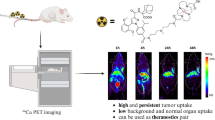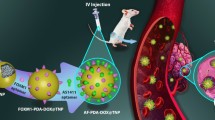ABSTRACT
Purpose
To investigate the arsonoliposome effect on medulloblastoma cells (VC312Rs) related to uptake, endocytotic mechanism and cell viability.
Methods
VC312R viability in presence of either arsonoliposomes or stealth liposomes was studied using MTT assay for 1–4 days. Fibroblasts (3T3) were used as control. Apoptosis was studied for 2 h, 5 h and 24 h. Bodipy-labelled arsonoliposome uptake (time- and dose-dependent) was estimated using FACS analysis. The endocytotic mechanism was investigated using inhibitors of clathrin- (chlorpromazine) and caveolae-mediated endocytosis (filipin).
Results
Arsonoliposomes affected significantly the VC312R viability compared to 3T3 cells and induced apoptosis to VC312Rs after 2 h of incubation. Apoptosis was not observed for 3T3 cells. Liposome uptake versus time showed a bimodal pattern. Clathrin-mediated endocytosis was the main endocytotic mechanism at low lipid concentrations and caveolae at higher ones; thus, dose-dependent uptake did not show a plateau at increased lipid concentrations.
Conclusions
Arsonoliposomes showed “selective” toxicity towards medulloblastoma cells inducing apoptosis after 2 hs of incubation. Therefore, arsonoliposomes are promising anticancer vehicles for brain tumour treatment.






Similar content being viewed by others
Abbreviations
- ABB:
-
annexin binding buffer
- Bodipy:
-
boron-dipyrromethene
- C16-As:
-
2,3-dipalmitoyloxypropylarsonic acid
- Chol:
-
cholesterol
- CPZ:
-
chlorpromazine hydrochloride
- DAPI:
-
4′,6-diamidino-2-phenylindole
- DHPE:
-
1,2-dihexadecanoyl-SN-glycero-3-phosphoethanolamine
- DMSO:
-
dimethylsulfoxide
- DSPC:
-
1,2-distearoyl-sn-glycero-3-phosphocholine
- FACS:
-
fluorescence-activated cell sorting
- FBS:
-
fetal bovine serum
- MEM:
-
minimum essential medium
- PBS:
-
phosphate buffer saline
- PFA:
-
paraformaldehyde
- PI:
-
propidium iodide
- PS:
-
phosphatidyl serine
- Rhod:
-
rhodamine
- SUPW:
-
sterile ultra pure water
- TNF-α:
-
tumoural necrosis factor
REFERENCES
Gilbertson RJ. Medulloblastoma: signalling a change in treatment. Lancet Oncol. 2004;5:209–18.
Cervoni L, Maleci A, Salvati M, Delfini R, Cantore G. Medulloblastoma in late adults: report of two cases and critical review of the literature. J Neurooncol. 1994;19:169–73.
Raffel C. Medulloblastoma: molecular genetics and animal models. Neoplasia. 2004;6:310–22.
Castello MA, Clerico A, Deb G, Dominici C, Fidani P, Donfrancesco A. High-dose carboplatin in combination with etoposide (JET regimen) for childhood brain tumors. Am J Pediatr Hematol Oncol. 1990;12:297–300.
Schuler D, SomLo P, Kooos R, Kalmanchey R, Paraicz E. Treatment of malignant scala posterior brain tumors in children: the chemotherapy of relapsed medulloblastoma with a dibromdulcitol containing drug regime and pharmacokinetic studies of dibromdulcitol in children. Med Pediatr Oncol. 1992;20:312–4.
Borsi JD, Csaki C, Ferencz T, Oster W. Administration of Ethyol (amifostine) to a child with medulloblastoma to ameliorate hematological toxicity of high dose carboplatin. Anticancer Drugs. 1996;7:121–6.
Fatouros D, Gortzi O, Klepetsanis P, Antimisiaris SG, Stuart MC, Brisson A, et al. Preparation and properties of arsonolipid containing liposomes. Chem Phys Lipids. 2001;109:75–89.
Gortzi O, Papadimitriou E, Kontoyannis CG, Antimisiaris SG, Ioannou PV. Arsonoliposomes, a novel class of arsenic-containing liposomes: effect of palmitoyl-arsonolipid-containing liposomes on the viability of cancer and normal cells in culture. Pharm Res. 2002;19:79–86.
Gortzi O, Antimisiaris SG, Klepetsanis P, Papadimitriou E, Ioannou PV. Arsonoliposomes: effect of arsonolipid acyl chain length and vesicle composition on their toxicity towards cancer and normal cells in culture. Eur J Pharm Sci. 2003;18:175–83.
Rejman J, Oberle V, Zuhorn IS, Hoekstra D. Size-dependent internalization of particles via the pathways of clathrin- and caveolae-mediated endocytosis. Biochem J. 2004;377:159–69.
Mosmann T. Rapid colorimetric assay for cellular growth and survival: application to proliferation and cytotoxicity assays. J Immunol Methods. 1983;65:55–63.
Meng W, Parker TL, Kallinteri P, Walker DA, Higgins S, Hutcheon GA, et al. Uptake and metabolism of novel biodegradable poly (glycerol-adipate) nanoparticles in DAOY monolayer. J Control Release. 2006;116:314–21.
Wang LH, Rothberg KG, Anderson RG. Mis-assembly of clathrin lattices on endosomes reveals a regulatory switch for coated pit formation. J Cell Biol. 1993;123:1107–17.
Huth US, Schubert R, Peschka-Suss R. Investigating the uptake and intracellular fate of pH-sensitive liposomes by flow cytometry and spectral bio-imaging. J Control Release. 2006;110:490–504.
Gumbleton M, Abulrob AG, Campbell L. Caveolae: an alternative membrane transport compartment. Pharm Res. 2000;17:1035–48.
Sieczkarski SB, Whittaker GR. Dissecting virus entry via endocytosis. J Gen Virol. 2002;83:1535–45.
Dai J, Weinberg RS, Waxman S, Jing Y. Malignant cells can be sensitized to undergo growth inhibition and apoptosis by arsenic trioxide through modulation of the glutathione redox system. Blood. 1999;93:268–77.
Haikou MN, Zagana P, Ioannou PV, Antimisiaris SG. Arsonoliposome interaction with thiols: effect of pegylation and arsonolipid content of arsonoliposomes on their integrity during incubation in glutathione. J Nanosci Nanotechnol. 2006;6:2974–8.
Evens AM, Tallman MS, Gartenhaus RB. The potential of arsenic trioxide in the treatment of malignant disease: past, present, and future. Leuk Res. 2004;28:891–900.
Zhu J, Koken MH, Quignon F, Chelbi-Alix MK, Degos L, Wang ZY, et al. Arsenic-induced PmL targeting onto nuclear bodies: implications for the treatment of acute promyelocytic leukemia. Proc Natl Acad Sci USA. 1997;94:3978–83.
Wang ZG, Rivi R, Delva L, Konig A, Scheinberg DA, Gambacorti-Passerini C, et al. Arsenic trioxide and melarsoprol induce programmed cell death in myeloid leukemia cell lines and function in a PmL and PmL-RARalpha independent manner. Blood. 1998;92:1497–504.
van Engeland M, Nieland LJ, Ramaekers FC, Schutte B, Reutelingsperger CP. Annexin V-affinity assay: a review on an apoptosis detection system based on phosphatidylserine exposure. Cytometry. 1998;31:1–9.
Andree HA, Reutelingsperger CP, Hauptmann R, Hemker HC, Hermens WT, Willems GM. Binding of vascular anticoagulant alpha (VAC alpha) to planar phospholipid bilayers. J Biol Chem. 1990;265:4923–8.
Timotheatou D, Ioannou PV, Scozzafava A, Briganti F, Supuran CT. Carbonic anhydrase interaction with lipothioars enites: a novel class of isozymes I and II inhibitors. Met Based Drugs. 1996;3:263–8.
ACKNOWLEDGEMENTS
Authors express their gratitude to Prof. Geoffrey J. Pilkington (School of Pharmacy and Biomedical Sciences, University of Portsmouth) for the kind donation of VC312R cells, Dr. Adrian Robins and Nina Lane (University of Nottingham) for their invaluable help with the FACS analysis, and Iain Ward (University of Nottingham) for his technical support on the confocal microscope. This project is part of a Ph.D. thesis funded by Medway School of Pharmacy, University of Kent/Greenwich, Kent, UK.
Author information
Authors and Affiliations
Corresponding author
Rights and permissions
About this article
Cite this article
Favretto, M.E., Marouf, S., Ioannou, P. et al. Arsonoliposomes for the Potential Treatment of Medulloblastoma. Pharm Res 26, 2237–2246 (2009). https://doi.org/10.1007/s11095-009-9940-0
Received:
Accepted:
Published:
Issue Date:
DOI: https://doi.org/10.1007/s11095-009-9940-0




